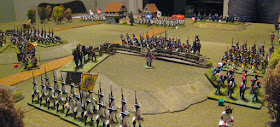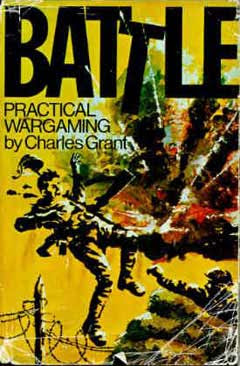Perhaps I should start by admitting that this is not the Battle of Langensalza. It is, in fact, the Battle of Seminole Ridge, as described in Charles Grant's Wargame Tactics. Of the battle reports in that book, it was Seminole Ridge which attracted me, but that battle was set in the American Civil War, and if replayed in the SYW it obviously needed a new title. 'Langensalza' was the battle in the book that actually was set in the SYW, so I swapped the names round. I hope that's all clear.
The battle is a traditional attack-defence setup, with (in my case) the Austrians defending a ridge line which covers 2 bridges. The bridges are the objective of the attacking Prussians. I went for a 6' x 6' table. The river can only be crossed at the bridges or ford.
The defenders hold the Langensalza Ridge and the ground to the south of it. The attackers deploy on their baseline along the north table edge with the objective of seizing the ridge and the bridges beyond. Mr Grant gave the attackers twice the number of units as the defenders, so I of course followed suit. Forces were:
Prussia (attacking)
Infantry brigade of 4 infantry battalions
Infantry brigade of 4 grenadier battalions
Infantry brigade of 1 Frei battalion, 2 jager battalions
Cavalry brigade of 2 cuirassier regiments
Cavalry brigade of 2 dragoon regiments and 1 hussar regiment
Artillery park of 3 medium batteries, 1 light battery and 1
howitzer battery
21 units.
Austria
(defending)
Infantry brigade of 3 infantry battalions
Infantry brigade of 1 infantry battalion and 2 grenz
battalions
Cavalry brigade of 1 cuirassier regiment and 1 dragoon
regiment
Artillery park of 2 medium batteries and 1 light battery.
3 feet of entrenchments
11 units.
To give some interest to the deployment process, I decided on the old school process of a curtain across the table, removed once deployment was complete. The details of how I contrive this are in an earlier post. We allocated sides by dice roll - I got the Austrians, my opponent Steve the Prussians. I'll take the liberty of describing the game from my perspective.
The Game.
Despite its rather Heath Robinson nature, the curtain went up easily enough, accompanied by comments about 'hanging out the washing on the Seigfried Line' from my opponent. There were further comments as we both set out our forces. I admit I do have a habit of muttering to myself when concentrating, but Steve's offer to call Social Services was typical of the sometimes hurtful badinage by which he seeks to gain a psychological advantage during our games. The swine. On removing the curtain, the two sides had deployed as per the photo below.
 |
| The cavalry melee intensifies as the dragoons of both sides clash. There really was only one possible outcome, but I felt I had little choice but to fight it out and hope for the best. |
 |
| Another overview around the same time. The noose is tightening around my troops, on both flanks. |
 |
| Another Austrian staff officer has an unexpected encounter with advancing enemy troops. The bridge is a new one acquired at 'Colours' in September. |
Conclusion.
I had been resoundingly thrashed, losing 7 of my 11 units, as well as one of the bridges and the whole of the ridge. Steve had lost only 2 of his 21 units. My tactics were certainly not the best. It was obvious from the start that my cavalry would be overwhelmed, and I should have redeployed some units to cover my left flank in anticipation of this. Both sides had their share of bad luck, so I certainly couldn't blame the dice rolls either.
There is the question of how evenly balanced the scenario was, but Mr Grant rarely gets these things wrong. The battle when played out in his book was a near run thing. I think I would add another infantry unit to the Austrian force in future, though.
The rules used were my own. Gaming time was about 2.5 hours. And yes, I did enjoy myself, despite a crushing defeat. That's wargaming, after all.
The rules used were my own. Gaming time was about 2.5 hours. And yes, I did enjoy myself, despite a crushing defeat. That's wargaming, after all.

















